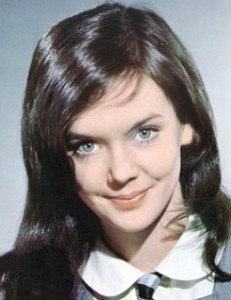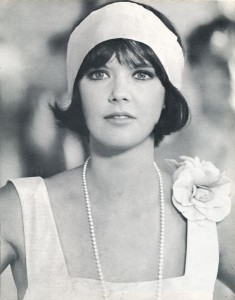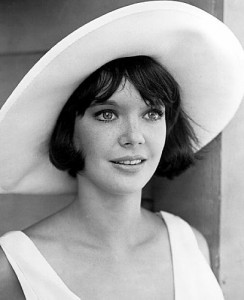PAMELA FRANKLIN
BY DANIEL OLIVER
It’s often been observed how British film-makers routinely waste their best actresses.
In which case, Pamela Franklin can count herself extremely lucky. As if sensing in advance how short her film career would ultimately be, directors and producers in the U.K. took every opportunity to capitalize upon her unique talent, providing this actress with an array of exceptional roles for as long as she remained active in the medium.
However, one should not attribute too much to luck here.
Franklin may well be the finest child performer ever to grace British screens, and her maturation into a young woman possessed of a singular dramatic presence managed, for a time, to buck the trend embodied by her contemporaries. For this reason, Franklin is particularly hard to categorize, as she refused (or was unable) to fall into the kind of pre-prepared roles that other young British stars working in the ’60s and ’70s appeared to have waiting for them.
Nonetheless, it is a mark of her talent that even from an early age, she was able to share the screen with the likes of Deborah Kerr, Maggie Smith, Bette Davis and Dirk Bogarde, but never once come off second best.
Franklin’s entry into films at the tender age of 11 in 1961 could not have been more auspicious, or more memorable. As one of the two children under Kerr’s care in Jack Clayton’s ‘The Innocents’, she managed to convey a sense of darkly shifting loyalties and motivations beneath the apparently sweet and utterly normal surface of a young girl.
Thus, whilst Franklin’s performance within that ghost story gives her the chance to open her face to the camera in a manner which is completely honest and sincere, the equal conviction with which she closes down again is disturbing: there is no petulance in Franklin, and when she goes quiet, you can be sure that she is quietly making plans.
This talent was rapidly capitalized upon when the lavish Cinemascope production of ‘The Lion’ (1962) brought Franklin to Hollywood, by way of Kenya. Here, she played a young girl living on a game reserve whose unspoken trauma at her parent’s divorce leads her into a dangerously close relationship with a fully grown lion.
Surrounded by a cast of international stars, Franklin is by far the strongest element in a film which plays as a travelogue with occassional moments of family drama thrown in. However, her performance here appears to issue from a much more intense, intimate and interesting little movie than the expansive and expensive one which the viewer ends up watching. It’s almost as if she is capable of pulling a sprawling studio production down to her own small scale, and rendering everything else in the film as irrelevent.
In the meantime, Disney, as is to be expected, took Franklin’s childish charm on face value. Soon she was appearing in their television film ‘The Horse Without A Head’ (1963), where she easily held her own amongst the family-friendly goings-on. Disney would use Franklin again the next year in their feature ‘A Tiger Walks’ (1964), but one seems to identify a misplaced enthusiasm in Uncle Walt regarding his use of this performer.
At this stage in Franklin’s career, her main strength as a screen presence was her ability to force the world of grown-ups to look her directly in the eye, and meet her on equal terms. Uncowed, despite her youth, and with a marked propensity to take on adults at their own game, she was absolutely everything that the sweetness and light of the biggest child star of this generation, Hayley Mills, was not.
Fortunately, another screen role soon arrived in Britain which used Franklin’s talents to their best advantage. ‘The Third Secret’ (1964) is a thriller revolving around themes of schizophrenia, suicide and murder. It placed Franklin in a supporting role as the fourteen year old daughter of a psychiatrist whose death is shrouded in mystery, and allowed her to shine in her most complex characterization yet.
By now, Franklin’s work proceeded in step with the 1960s itself, almost becoming a conduit for larger social changes underway during that time.
The mix of knowing innocence and family-oriented friendliness which had previously characterized her roles would eventually become redundant. Franklin was halfway through her teens by the middle of the ’60s, and for the next five years, that maturity which seemed so disconcerting in her earlier performances would come into its own.
A fine indication of how this actress’s roles were growing up with her is provided by her appearance in ‘The Nanny’ (1965).
Playing the older confidante of a boy who fears that his guardian (played by Bette Davis) is harbouring murderous intentions, what Franklin offers is more than simple advice or good sense to her friend: it is downright provocation of a mutual enemy. Franklin as an actress had now begun, on the cusp of womanhood, to channel something approaching a shameless defiance of that adult world which she was in the process of entering.
All the early promise this performer had displayed in ‘The Innocents’ finally began to pay off when she was reunited with the director of her debut film, Jack Clayton, for ‘Our Mother’s House’ (1967).
The film in question is a brilliantly morbid and claustrophobic tale of seven children who, after the death of their deeply religious mother, bury her in the back garden of their house before resuming life as normal. This scenario provided the perfect platform for all the darkness, anger and confusion that one could sense shifting beneath Franklin’s previous performances. Here, they became unleashed with a burning and wounded intensity.
As the eldest of the clan, Franklin institutes rules based upon an interpretation of her dead mother’s legacy, organizing the daily lives of her siblings and marshalling them in order to keep the outside world at bay. Working herself into trances in order to communicate with the spirit world, she finds her judgment increasingly blinded by an inchoate and adolescent rage. Into this setting, it is the arrival of a stranger (Dirk Bogarde), claiming to be the father of the family, which finally pushes Franklin’s character over the edge.
After this film, there was only one young actress who could possibly fill the role of Sandy when Ronald Neame shot his adaptation of ‘The Prime of Miss Jean Brodie’ in 1969. As the prize pupil of Maggie Smith’s titular teacher at a private girls’ school during the ’30s, Franklin is fearless in depicting the journey from intelligent and perceptive schoolgirl, through to model and mistress, to an eventual transformation into the ‘assassin’ who finally puts paid to Brodie and her toxic influence.
As if to emphasize the distance travelled by Franklin since the beginning of the ’60s, her nude scenes and sexual awakening as Sandy in ‘…Brodie’ are one of the catalysts for that character’s eventual rebellion against those conventions inside which she has been raised.
On reflection, this also gestures towards those upheavals undergone by British society in the preceding ten years which run alongside Franklin’s development as an actress.
Intriguingly, although Muriel Spark’s novel depicts Sandy’s later life as a nun, this doesn’t seem to be the impression generated by Franklin in the film. Her final march away from the school occurs as an extended tracking shot, with Franklin’s presence therein seeming too purposeful and determined, and her overall characterization of Sandy too vital, engaged and passionate, to withdraw from society in such a manner.
Which begs the question of where this character is ultimately heading. With a defiant fire in her heart, and with war encroaching, Franklin as Sandy appears radicalized in reaction against her experiences under Brodie. Fiercely intelligent, capable, and with her ruthless streak already shown, is it stretching a point to imagine this young woman arriving in occupied Europe as a Salesman for the SOE? Something larger than self-determination, perhaps the call of history, echoes through that final shot we see of Franklin.
Those closing moments turn a page on this actress’s work in the ’60s, and their ambiguity also embodies the uncertainty which Franklin’s career would subsequently face.
The early 1970s heralded a flood of television work in the United States, and even the most charitable fan would be hard pressed to recognize this career path as anything other than a tremendous squandering of talent. Franklin was inexplicably turning into a ‘face’ performer, as a naturally photogenic and professional actress who could say her lines well and improve mediocre material. But all those fascinating undercurrents and uncertainties which made this performer shine were being neglected, with formulaic shows such as ‘Green Acres’ (1971) and ‘Bonanza’ (1972) failing to do justice to her unique capabilities.
Two feature films from this period are of note: the first is ‘And Soon The Darkness’ (1970), a tense thriller from the directing and writing team of Robert Fuest and Brian Clemens, who had both enjoyed great success with ‘The Avengers’ on television a few years previously.
The film concerns two English girls on a cycling tour in the South of France. The disappearance of one places the other in a nightmarish situation, leaving her isolated, unable to speak the language, and not knowing who to trust. Whilst undeniably clammy and grim, allowing Franklin to generate a performance from facial expressions rather than dialogue, ‘And Soon The Darkness’ requires nothing from its lead that couldn’t have been fulfilled equally well by a host of other British actresses available at the time.
Her second notable film around this period is ‘The Legend of Hell House’ (1973), which thankfully sees this performer back in Britain and close to her best, playing a fragile medium assigned as part of a team to investigate the malefic legacy of a long-deserted mansion.
Franklin again demonstrates how she profited most from roles involving the harbouring of secrets. Initially a confident, calmly perceptive individual, her spiritual gifts are repeatedly dismissed by the leader of the investigation, and Franklin’s resultant anger exposes her to exploitation by the dark forces gathered in the house.
With her capabilities as a medium slowly turned against her, she surrenders her virginity to one of those resident ‘presences’, whereupon Franklin delivers one of the film’s outstanding moments: her body left scratched and bruised by unseen hands, and hunched upon her bed, a colleague rushes to her side to discover Franklin not crying, or in pain, but laughing.
…Hell House’ once more illustrated how it was Britain which routinely provided Franklin with her best roles. One wonders if, even accounting for the parlous state of British filmmaking during the ’70s, her prospects wouldn’t have been better by simply staying put in the U.K.. Whilst many actresses from that island would eventually feel compelled to decamp to the U.S. in search of more fulfilling roles, Franklin appeared to be under no such pressure: if anybody could have made the most of those reduced opportunities available within British film production during the 1970s, it was her.
And yet soon after, she moved Stateside to devote her career almost exclusively to television. Why? It’s difficult to answer that question without Franklin herself volunteering such information, and interviews with this actress are very scarce.
She stayed visible on the small screen for most of the ’70s, thanks to guest appearances in era-defining shows such as ‘The Streets of San Fransisco’ (1974), ‘The Six Million Dollar Man’ (1974), ‘Cannon’ (1972/74), ‘Petrocelli’ (1975), ‘Hawaii Five-O’ (1977) and ‘The Love Boat’ (1977). But whilst Franklin maintained her professionalism in these supporting roles, she was rarely stretched in the way her talent demanded.
Her last acting work in Britain occurred in ’74/’75 and was occasioned by the shooting of two separate episodes for Brian Clemens’s series of self-contained dramas, ‘Thriller’.
The first, ‘Screamer’, gives Franklin some properly substantial material once again, playing a rape victim released after several months of therapy into the care of her friends. However, when a journey into town one day reveals her supposedly apprehended attacker still at liberty, the chance to exact murderous revenge presents itself. Franklin handles the material with aplomb, retaining the audience’s sympathies even as her character’s plans go awry and her sanity comes into question. As such, the script allows this actress to tap into that contained, low level intensity which was one of her great gifts as a performer.
A year later, her second appearance in the ‘Thriller’ series, ‘Won’t Write Home Mom, I’m Dead’, sees Franklin as a woman whose telepathic link to her missing fiancé places her in danger from an unseen foe.
More interesting than anything which occurs onscreen during this episode is the fact that the producers once again cast Franklin as an American visitor to England. This unavoidably reflected the decisive way this actress had burnt her bridges to that country which had facilitated her best work. Furthermore, those themes of telepathy in ‘Won’t Write Home…’ showed up the typecasting she was experiencing in the horror genre.
Titles such as ‘Necromancy’ (1972) and ‘Satan’s School For Girls’ (1973) had begun this trend earlier in the decade, and the nadir came with what proved to be Franklin’s final big screen appearance, in 1976. The spectacularly tacky exploitation flick ‘The Food Of The Gods’ saw this once vital performer now struggling to maintain her dignity in a film filled with giant chickens, rats, wasps and worms.
Other television guest appearances in the U.S. came and went for the remainder of the ’70s, but it was increasingly clear how American television and film producers did not have a clue what to do with Franklin. At her best, she was too vulnerable, too intelligent, too dangerous and sometimes just too downright ambiguous for them to deploy properly.
Additionally, Frankin’s heart no longer seemed to be in the acting game, and in 1981, at the age of 31, she retired from the business and stayed in the United States to raise a family. She has not been seen on screens (large or small) since.
Thankfully, her chances of being forgotten are remote. Anyone familiar with the medium will always remember her appearances in some of the best screen roles ever made available to a young actress. The conviction she brought to these characters, the lack of any cliché or petulance she demonstrated, along with her refusal to play down to the usual expectations placed upon adolescent performers, continues to impress.
As a screen presence, she was petite, contained, and unpredictable, capable at a moment’s notice of transforming an appreciative smile into an accusatory glare, whilst her own amenably sweet façade acted as guardian to a mature and unforgiving awareness of the world around her.
Franklin possessed a unique talent which, for a short but precious period of time, shone.


![flareplayers.com-pamela-franklin-1[1]](http://2013.rhubba.com/net/wp-content/uploads/2013/10/flareplayers.com-pamela-franklin-11.jpg)




